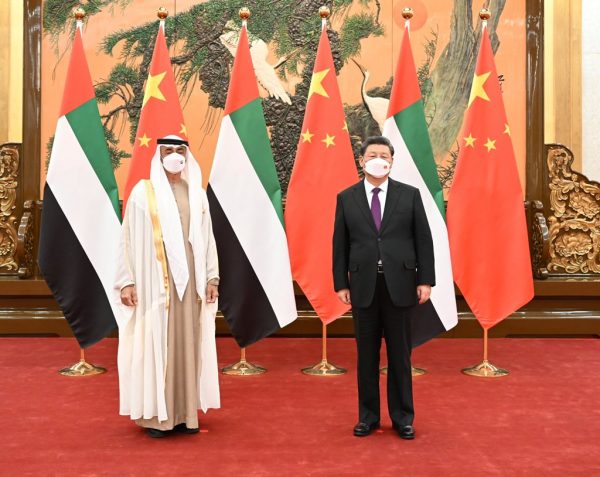Over the past three decades the MENA has graduated from a region of peripheral importance to China to one ranking much higher in Beijing’s strategic calculations. During that time, China has developed multifaceted relationships with all the MENA countries and has risen to become the most consequential and influential extra-regional actor next to the United States in an era of unfolding US–China global strategic competition.
Sino–Gulf relations illustrate the upward trajectory and increasingly complex pattern of China’s partnerships across the MENA region, which encompass various forms of cooperation within and beyond the energy sector. Energy partnerships, which have served as the backbone of Sino–Gulf relations, have over the years become increasingly complex and mutually advantageous.
They now include joint ventures between Chinese and Gulf energy enterprises, Chinese investments in Gulf upstream industries and renewables, Gulf Arab stakes in China’s downstream markets, such as investments by Saudi Aramco in a refinery and petrochemical facility in Zhejiang and by Kuwait in a refinery in Zhanjiang, and nascent cooperation in developing hydrogen projects.
China has risen to become the predominant market for Gulf crude oil exports, a top destination for Qatari liquified natural gas (LNG), the Gulf Cooperation Council (GCC) countries’ leading trade partner, a ‘lifeline’ for heavily-sanctioned Iran, a valuable source of investment for a fragile Iraq struggling to rebuild its economy and a niche arms exporter.
Since General Secretary Xi Jinping’s launch of the BRI in 2013, Chinese activities in the Gulf have expanded into new frontiers, notably the development of physical and digital infrastructure. Within the BRI framework, Chinese construction contracts and investments in infrastructure mega-projects across the GCC and Iraq have surged. While the latter have consisted primarily of ‘oil-for-projects’ deals largely in energy infrastructure and school construction, the former have focussed on creating ‘trade hubs’ that combine port developments with investment zones, smart-city infrastructure, and manufacturing and logistics facilities.
Lately, extensive investments by GCC countries seeking to adapt the technologies they use to the coming digital transformation have opened new vistas for Sino–Gulf cooperation. GCC countries have made rapid progress in the deployment of digital products and services. Internet penetration and mobile broadband and smartphone rates in the Gulf’s Arab states compare favourably worldwide. Digital banking and payment systems have spread widely if unevenly, e-commerce and online entertainment have expanded, and unicorn startups have sprouted.
The UAE, Saudi Arabia and Kuwait have each launched various digital initiatives as a core component of their respective Vision 2030 plans to spur growth and promote employment. The UAE is the trailblazer in the deployment of high-speed telecom infrastructure. Several financial technology (fintech) firms have moved to the UAE. Meta has established a virtual hub in Qatar for small- and medium-sized businesses with training webinars on digital marketing.
Saudi Arabia recently awarded licenses to several companies to provide digital government services. Still, the Gulf’s digital revolution is far from complete. Domestic digital industries are at an early stage of development. Digital assets are not fully integrated across economic sectors. Building a critical mass of local digital talent to drive innovation and local production remains a work in progress.
Enter China, whose digital footprint in the region has expanded, catalysed by the introduction of the Digital Silk Road (DSR), an offshoot of the BRI, in 2015. Since then, leading Chinese tech titans including Alibaba, as well as major telecoms and infrastructure vendors, notably Huawei, have taken part in the Gulf’s digital transformation — providing a wide range of technologies from end-user devices to servers, mobile infrastructure and cloud platforms.
Several factors have enabled Sino–Gulf relations to flourish. Chinese opportunism is one of them. China has capitalised on Iran’s poisoned relations with the United States, Western companies’ risk aversion in Iraq and the widespread perception among the GCC countries of US retrenchment. Beijing has deftly navigated regional rivalries such as between Saudi Arabia and Iran.
Beijing has embraced a development-focussed, apolitical ‘win-win’ model, presented as an alternative to the US-led Western approach, which it has depicted as overly militarised and meddlesome. For their part, China’s Gulf partners have found Beijing’s state-led rapid modernisation paradigm and deep pockets attractive. They see China’s BRI as compatible with their respective Vision 2030 economic diversification blueprints.
Yet Chinese inroads into the Gulf and wider Middle East have taken place amid intensifying US–China global strategic competition — and have further inflamed it. Of the various strands of China’s engagement with the region, the digital bridgehead in the Gulf established by Chinese tech companies appears to have evoked the most concern among US policymakers.
Wary of the security implications of China’s growing ability to exert influence over the region’s technology ecosystems, the United States has pushed back, waging a ‘clean network’ campaign which has sent regional states scrambling to find ways to hedge their bets.
The Gulf has emerged as an important arena of escalating US–China strategic competition — the region’s cyberspace is a new frontier in that rivalry.
John Calabrese is Assistant Professor at American University, Washington DC. He is a Senior Scholar at the Middle East Institute where he directs the Middle East–Asia Project.

